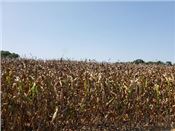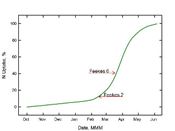Impact Of Drought On Residual Soil Nitrate
DR. NUTIFAFA ADOTEY AND DR. TYSON RAPER
JACKSON, TENNESSEE
Abnormally dry soil conditions as a result of rainfall amounts far below average during this corn growing season present unique nutrient management decisions after harvest, particularly for growers considering wheat crop this fall. This article will address two key questions that may come handy in making management decisions: Is there be considerable amounts of residual soil N left after the 2022 corn crop? and if the residual soil nitrate is sufficient to meet N demand of the wheat crop in the fall?
Is there be considerable amounts of residual soil N left after the 2022 corn crop?
Generally, most of the N from fertilizer is converted to nitrate three weeks after fertilizer application. Nitrogen loss (ammonia volatilization, denitrification, and leaching), plant N uptake, and rainfall amount and intensity can have an impact on potential nitrate availability in the soil after harvest. This year, ammonia volatilization was the primary N loss pathway for surface applied urea- based N fertilizer and this loss could account for up to 30-50 percent of the total N applied. Another loss pathway that may have impacted a few counties in northwest TN is denitrification, when heavy rainfall fell on recently applied sidedress N. However, the unusually dry soil conditions this year generally minimized N loss through denitrification and leaching. As a result of the dry soil conditions, there was a considerable reduction in nutrient uptake from the soil.
Limited nutrient uptake means the unused N may remain in the soil.
Is the residual soil nitrate sufficient to meet N demand of the wheat crop in the fall?
The University of Tennessee’s recommendation for fall N is 15 – 30 pound of N depending on prior crop and planting date. Wheat crop takes up little N until feekes growth stage 2, at which point N update increases exponentially and continues at this rate through much of the spring (Figure 1). As pointed out earlier, many fields likely have higher residual nitrate in 2022 than in a normal crop year and this nitrogen should be sufficient to meet the fall wheat demand. Unless we experience numerous heavy rains that result in denitrification, the soil nitrate will be available for the wheat crop.
So, you may be wondering if there enough residual N to meet part of the demand through the spring. At this point, we do not know exactly how much might remain in the system. Research completed at the University of Kentucky and at other locations in the southeast suggests we can use tiller counts in early spring to gauge N availability and fine-tune N fertilizer timing(s) and quantity(ies), and that method might be the best way for us to capture the value of the residual N remaining from the 2022 season without risking deficiencies in the wheat crop. Watch the blog for information on how to use tiller counts to fine-tune spring N applications as we move closer to February. ∆
DR. NUTIFAFA ADOTEY: Soil and Nutrient Management Extension Specialist, University of Tennessee
DR. TYSON RAPER: Cotton & Small Grains Specialist, University of Tennessee

